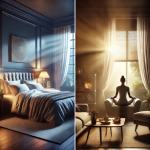Explore the Symptoms and Effects of Seasonal Affective Disorder (SAD)
Seasonal Affective Disorder (SAD) is a unique form of depression that typically arises during the fall and winter months, coinciding with the reduction of natural sunlight. Many individuals who find themselves increasingly feeling fatigued, irritable, or socially withdrawn as daylight hours shorten may be experiencing SAD. Common symptoms include persistent feelings of sadness, changes in sleep patterns, trouble focusing, and a marked loss of interest in activities that once brought joy. Recognizing these signs is vital for seeking help and implementing lifestyle changes that can significantly improve mental health and overall well-being.
Apart from emotional challenges, those suffering from SAD frequently undergo appetite changes, particularly a heightened craving for high-carbohydrate foods, which can exacerbate feelings of fatigue and lethargy. The prevalence of SAD is notably higher in regions farther from the equator, where winter days are much shorter. Studies reveal that roughly 5% of adults in the United States experience symptoms of SAD, with women being statistically more vulnerable than men. Understanding the widespread nature of this disorder can offer solace to those affected, fostering a sense of connection and reducing feelings of isolation.
The symptoms of SAD typically begin in late autumn and can persist until spring, creating a cyclical pattern that can be particularly difficult to manage. Acknowledging that numerous others face similar challenges during these darker months is crucial, as validating these feelings can serve as a critical first step towards discovering effective strategies for coping with this condition.
Actionable Strategies to Effectively Combat Seasonal Affective Disorder (SAD)
- Seasonal Affective Disorder (SAD) is a recurring type of depression that significantly impacts individuals during the fall and winter seasons, particularly when there is a notable decrease in sunlight exposure.
- Utilizing Light therapy and maximizing opportunities for natural sunlight exposure can greatly reduce SAD symptoms by aiding in the regulation of the body's internal clock and improving mood.
- Incorporating regular physical exercise into your routine has proven benefits for enhancing mood, reducing stress, and boosting energy levels for those coping with SAD.
- Maintaining a well-rounded and nutritious diet, rich in essential vitamins and minerals, is crucial for supporting overall mental health and effectively managing the symptoms of SAD.
- Building and sustaining social connections, along with seeking support from friends and family, can significantly ease feelings of isolation and loneliness that often accompany SAD.
 Maximizing Light Therapy and Natural Sunlight to Effectively Manage SAD
Maximizing Light Therapy and Natural Sunlight to Effectively Manage SAD
Light therapy has gained widespread recognition as one of the most effective treatments for Seasonal Affective Disorder (SAD). This method involves exposure to bright artificial light that mimics natural sunlight, proving especially beneficial for individuals who experience low moods during the winter months. Investing in a quality light therapy box can dramatically enhance your mood and overall well-being. These devices emit bright light that aids in regulating your circadian rhythms, lifting your spirits throughout the darker seasons.
To achieve optimal results, it is recommended to use the light therapy box for about 20 to 30 minutes each morning, ideally soon after waking up. This practice signals to your body that it is time to be active and alert, effectively counteracting the sluggishness that can accompany limited sunlight exposure. In addition to light therapy, making the most of natural sunlight whenever possible can significantly boost your mood and energy levels.
On bright days, prioritize outdoor activities, whether it's taking a brisk walk during your lunch break or indulging in recreational hobbies. Embracing natural light not only uplifts your spirits but also helps increase vitamin D levels, which are essential for supporting overall mental health.
Opening your curtains wide during the day allows in more natural light, creating a brighter environment that can enhance your mood and overall emotional state.
For those living in areas with extended winters, planning outdoor excursions during weekends or holidays to maximize sunlight exposure can be extremely beneficial. Engaging with nature not only provides essential light exposure but also offers a refreshing change of scenery, significantly boosting your overall well-being.
 The Transformative Power of Regular Exercise on Symptoms of Seasonal Affective Disorder
The Transformative Power of Regular Exercise on Symptoms of Seasonal Affective Disorder
Incorporating consistent exercise into your daily life can greatly alleviate the symptoms associated with Seasonal Affective Disorder (SAD). Physical activity is known to trigger the release of endorphins, which are the body's natural mood lifters that help combat feelings of sadness and lethargy. If staying motivated during the winter months proves challenging, consider setting achievable fitness goals that are manageable for you.
Whether it be taking a brisk walk around your neighborhood or engaging in a quick home workout, discovering enjoyable activities can have a profound impact on your emotional health. Aim for at least 30 minutes of moderate exercise most days of the week; if needed, you can break this down into shorter segments that fit into your schedule. Outdoor pursuits can be particularly beneficial during colder months.
Embrace winter by participating in activities such as hiking, skiing, or ice skating. Not only do these activities provide necessary physical exercise, but they also allow you to soak up natural light and fresh air, both of which are crucial for uplifting your mood. If outdoor activities are not feasible due to bad weather, consider joining a local gym or taking part in indoor classes that interest you.
The key is to find something enjoyable that keeps you active while helping to lessen the feelings of isolation that are often linked to SAD.
 Boosting Mental Health Through Balanced Nutrition and Mindful Dietary Choices
Boosting Mental Health Through Balanced Nutrition and Mindful Dietary Choices
Your dietary choices hold significant sway over your physical and mental well-being, especially during the winter months. As temperatures drop, cravings for comfort foods—often high in carbohydrates and sugars—tend to increase. While occasional indulgence is perfectly fine, prioritizing a balanced diet rich in essential nutrients is key to stabilizing mood and maintaining energy levels.
Focus on incorporating a diverse array of fruits, vegetables, whole grains, and lean proteins into your daily meals. Foods high in omega-3 fatty acids, like salmon and walnuts, have been shown to possess mood-boosting properties, making them particularly advantageous for individuals dealing with SAD. Additionally, being mindful of meal timing can yield positive results.
Regular meals contribute to stable blood sugar levels, which can help mitigate mood swings and irritability. Staying adequately hydrated is equally essential; dehydration can lead to fatigue and reduced concentration. When snacking, choose healthier alternatives such as nuts or yogurt instead of sugary treats to combat low energy levels.
By being conscious of your nutrition during the darker months, you can significantly enhance your mental health and overall emotional well-being.
Establishing Strong Social Support Networks to Combat SAD
Maintaining social connections is vital for mitigating the feelings of isolation that often accompany Seasonal Affective Disorder (SAD). During the winter months, the urge to retreat into solitude can be strong; however, reaching out to friends and family can provide essential support and encouragement. Make it a priority to schedule regular catch-ups with loved ones through phone calls, video chats, or in-person meetings whenever possible.
Sharing your experiences with those who understand your struggles can help lighten the emotional load associated with SAD. Consider joining local clubs or groups that align with your interests; this creates opportunities to meet new people and engage in social activities that can elevate your mood. Volunteering also serves as a fantastic way to connect with others while making a positive impact in your community.
Helping others fosters a sense of purpose and fulfillment, which can effectively counteract feelings of sadness. Cultivating and nurturing social connections may require effort, but it can significantly enhance your emotional resilience during challenging times.
Incorporating Mindfulness and Meditation for Relief from Seasonal Affective Disorder
Utilizing Mindfulness Practices for Effective Management of SAD Symptoms
Practicing mindfulness and meditation can be incredibly effective approaches for managing the symptoms associated with Seasonal Affective Disorder (SAD). These techniques foster a focus on the present moment, helping to alleviate the preoccupation with negative thoughts or feelings linked to past experiences or future uncertainties.
Mindfulness practices can ground you, providing greater emotional clarity and tranquility amid the challenges posed by seasonal changes.
Getting Started with Mindfulness Techniques for Beginners
If you are new to mindfulness, begin your journey with just a few minutes of daily practice. Find a quiet space to sit comfortably and focus on your breathing. As thoughts arise, acknowledge them without judgment and gently guide your focus back to your breath.
Incorporating Mindfulness into Daily Routines for Enhanced Well-Being
Integrating mindfulness into your everyday activities can yield substantial benefits. Whether enjoying a meal or taking a leisurely stroll, immerse yourself fully in the experience while minimizing distractions. This practice can help alleviate anxiety and enhance your overall emotional health.
Exploring Guided Meditation Resources for Improved Focus and Clarity
Additionally, consider exploring guided meditation applications or online platforms that offer structured sessions specifically designed to help manage depression and anxiety. Dedicating time to mindfulness and meditation can lead to greater peace and clarity during the darker months.
 Seeking Professional Guidance for Effective Management of Seasonal Affective Disorder
Seeking Professional Guidance for Effective Management of Seasonal Affective Disorder
When self-help strategies fail to alleviate the symptoms of Seasonal Affective Disorder (SAD), seeking professional assistance may become essential. A qualified mental health professional can provide invaluable support through personalized therapy or counseling tailored to your unique circumstances. Cognitive-behavioral therapy (CBT) is particularly effective for treating SAD, as it helps individuals identify negative thought patterns and develop healthier coping strategies.
Do not hesitate to seek help if you feel overwhelmed; reaching out to a therapist or counselor who understands your situation is a completely valid step. They can work with you to create a customized treatment plan that may include therapy sessions, medication if necessary, or other interventions aimed at improving your mental health during difficult periods. It’s essential to recognize that seeking help is not only acceptable but is an important act of self-care that significantly contributes to your overall well-being.
 Creating a Nurturing and Supportive Home Environment for Enhanced Mental Health
Creating a Nurturing and Supportive Home Environment for Enhanced Mental Health
Establishing a nurturing home environment can greatly affect your mood during the winter months. Start by decluttering your living space; a clean and organized environment fosters feelings of calmness and control. Incorporate elements that bring you joy—such as artwork, plants, or soft textiles—to create a warm and inviting atmosphere conducive to relaxation.
Lighting is crucial; choose bright bulbs or warm-toned lamps that mimic natural light to brighten your living area. Surround yourself with uplifting reminders—photos of loved ones or motivational quotes—that can inspire positivity during challenging times. Furthermore, develop routines that encourage self-care; dedicating time each day to activities that bring you joy, such as reading, crafting, or cooking, can help maintain a sense of normalcy amid seasonal changes.
By embracing these strategies during the darker months, you can effectively manage Seasonal Affective Disorder. Remember that it is perfectly acceptable to seek help when needed; prioritizing your mental health is vital for successfully navigating this challenging season.
Seasonal Affective Disorder (SAD) can be a complex condition to manage, especially during winter when daylight is scarce. For additional support, consider exploring a helpful article that discusses coping mechanisms for SAD: Budgeting Tips for Tough Times Amid Rising Costs. This resource offers practical advice on managing financial stress, which can significantly worsen SAD symptoms. By implementing effective budgeting strategies and alleviating financial pressures, individuals may find relief from some of the emotional and psychological challenges associated with SAD.
Common Questions About Seasonal Affective Disorder (SAD)
What Is Seasonal Affective Disorder (SAD) and Its Effects on Individuals?
Seasonal Affective Disorder (SAD) is a type of depression that typically arises at certain times of the year, predominantly during winter when daylight hours are significantly reduced.
What Symptoms Are Commonly Associated with Seasonal Affective Disorder (SAD)?
Symptoms of SAD may include feelings of sadness, hopelessness, low energy, changes in appetite or weight, difficulties concentrating, and a loss of interest in activities that were once enjoyable.
What Are Effective Coping Strategies for Seasonal Affective Disorder (SAD)?
Effective coping strategies for SAD include engaging in light therapy, maintaining a regular exercise routine, spending time outdoors, ensuring a healthy and balanced diet, and seeking support from friends, family, or mental health professionals.
How Does Light Therapy Benefit Individuals with Seasonal Affective Disorder (SAD)?
Light therapy involves sitting in front of a specialized light box that emits bright light, which can assist in regulating the body's internal clock and enhancing mood for those affected by SAD.
What Self-Care Techniques Can Be Utilized to Manage Seasonal Affective Disorder (SAD)?
Self-care techniques for managing SAD include practicing relaxation methods, maintaining regular sleep patterns, effectively managing stress, and engaging in activities that foster joy and fulfillment.
This Information is Provided By: Survival Psychology
The post Seasonal Affective Disorder (SAD): Coping Mechanisms appeared first on Survival Bite.
The Article Coping Mechanisms for Seasonal Affective Disorder (SAD) Was Found On https://limitsofstrategy.com
The Article Coping with Seasonal Affective Disorder (SAD) Effectively First Appeared ON
: https://ad4sc.com



Ah, Seasonal Affective Disorder—just the universe’s way of reminding us that our ancestors probably didn’t have Netflix and indoor heating to distract them during the endless gray months. It’s funny (and not-so-funny) how we can go from enjoying the vibrancy of summer to feeling like we’ve been wrapped in a cozy but suffocating blanket made of sadness and lethargy. I don’t know about you, but my biggest seasonal challenge is resisting the siren call of my sofa during the winter.
I get what you mean about that cozy yet suffocating blanket feeling during winter. There’s something so primal about it, almost like our bodies are reacting to those shorter days and colder nights in a way that echoes our ancestors’ experiences. Without Netflix or warm homes, I can only imagine how they coped with the dark months.
I get that winter slump; it’s a tough time for so many of us, but I recently came across some solid tips on keeping your hair healthy through the dreary months—thought it might help lighten the load a bit.
‘Winter Hair Care Tips for Seasonal Preparation’
https://oldicom.net/winter-hair-care-tips-for-seasonal-preparation/.
You really captured that cozy-yet-suffocating winter vibe perfectly. It’s fascinating to think about how our ancestors adapted to those long, dark months without the comforts we have today. I often find myself longing for simpler times while also feeling overwhelmed by modern life’s pace. The contrast between seeking warmth and comfort and battling the winter blues is such a relatable struggle.
I totally get that winter can feel heavy, and if you’ve ever dealt with heartburn during those cozy nights in, I stumbled upon some helpful insights on how acupuncture might just offer some relief when those seasonal comforts turn sour.
‘Acupuncture for Effective Heartburn Relief Benefits’
https://oldicom.net/acupuncture-for-effective-heartburn-relief-benefits/.
Seasonal Affective Disorder (SAD) is definitely a topic that deserves more attention. I’ve experienced the winter blues myself, and the shift in mood with the fading sunlight can feel almost dramatic. I find that the cravings for comfort foods you mentioned often lead me to a cycle of lethargy, making it tough to break free.
This post brings to light such an important and often overlooked topic! I’ve personally experienced the seasonal shift in mood, especially during those long winter months when sunlight feels scarce. It’s fascinating how our environment can impact our mental health so significantly. I remember a few winters ago feeling particularly low as the days got shorter. It was during that time I discovered light therapy lamps. They really helped me feel more energized and balanced.
It’s really interesting to hear about your experience with seasonal mood shifts. Many people can relate to that feeling of heaviness when winter rolls in and the days grow short. It’s a challenge that seems to catch us off guard each year. The connection between our environment and mental health is potent—sunlight plays a crucial role in regulating our mood and energy levels.